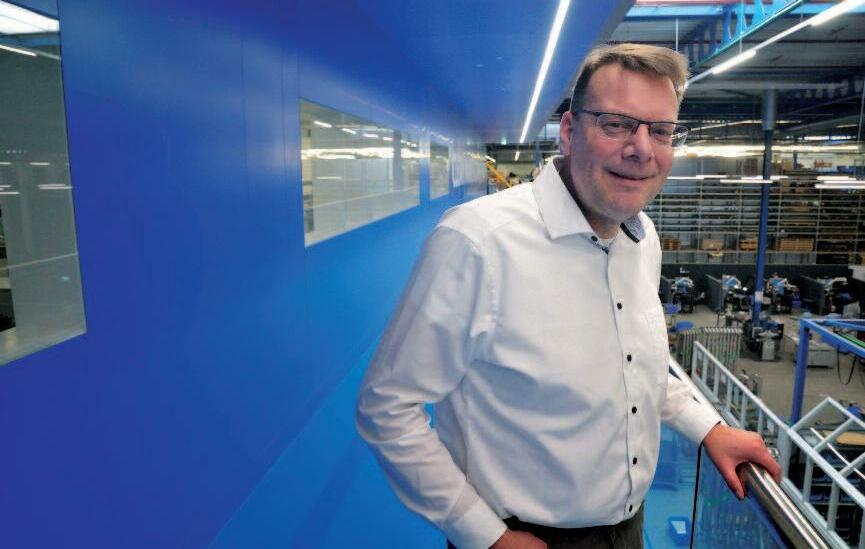SERVITIZATION
BUSINESS MODEL IN THE SPOTLIGHT IN ‘SERVITIZATION: DESIGN FOR SERVICE’ WORKSHOP
PHILIPS AND THERMO FISHER SCIENTIFIC: INCREASED TURNOVER WITH DIGITAL SERVICES
The shift from selling products to service subscriptions is an important pillar in the servitization business model. Even for large companies like Philips and Thermo Fisher Scientific, the required digital transformation is still a major challenge. This emerged from their presentations during the ‘Servitization: Design for Service’ workshop at the High Tech Campus Eindhoven in late February. Organising the event was the European Supply Chain Forum of Eindhoven University of Technology in partnership with the Servitization Platform of Link Magazine. ‘This is not so much about operational excellence but about customer value.’
customer smart solutions, for example for their performance improvement or predictive maintenance. ‘The trick is to combine human and artificial intelligence in order to take the best decisions.’ Boosten cites the example of an integrated solution in the field of imageguided intervention. ‘Philips supplies the system along with the required catheters and the software for navigation during the intervention plus cathlab managed services; in this way, we are able to help the hospital manage their lab. XaaS, ‘anything as a service’, is the underlying delivery model for this strategy.’
CONTINUOUS IMPROVEMENT
At Thermo Fisher Scientific, the initial drive for servitization was making the lives of the field service engineers easier with smart tooling. Photo: Thermo Fisher Scientific
BY HANS VAN EERDEN
T
hese days, Design for Service also falls under the term DfX (Design for X, in which X stands for manufacturing, assembly, etc.). So says Néomie Raassens of the European Supply Chain Forum when introducing the workshop. In this context, she says, service is primarily understood to mean the product plus the services that can be provided around it. ‘Most Design for Service methods are still mainly product-centred and not primarily focused on the user. That is to say, the user requirements are not included in the design from the start.’ For that reason, this afternoon the focus is on designing/redesigning products with an eye to service delivery,
14
providing services focused on the user, explains Raassens.
INTEGRATED SOLUTIONS The first speaker is Marcel Boosten, lead architect for Philips Services, responsible for Design for Serviceability at Philips. ‘Our task is to help the business units with the in-design of serviceability in their products. The strategy of Philips as a healthcare company is to transform from a productbased business to a supplier of services and solutions. We supply more and more integrated solutions, combinations of products and services.’ Those services are usually cloud-based, they often work remotely and they make use of big data and artificial intelligence (AI) in order to offer the
Special High-tech The Netherlands - April 2022
By way of illustration, Boosten compares the ‘old’ business model to a XaaS model from the customer perspective. Traditionally, the customer buys a system, for example a complex, expensive MRI or CT scanner, and uses it until end-of-life. ‘The customer draws up the requirements beforehand and then has to make the right procurement choice based on them. This comes with high capital costs and therefore a high entry threshold. The capabilities of the purchased solution are constant over its lifecycle and so, therefore, is the value the customer derives from its use. Added value can come from upgrades. These are often options that the customer decides not to buy initially, but at a later date. Typically, these options already exist at the time of sale. In the ‘old’ business model, the user is responsible for realising that value.’ On the other hand, in XaaS the customer does not have to make an expensive purchase but instead takes out a subscription to a service, so the entry threshold is low. The medical system, which remains the property of the supplier – Philips – functions as the platform for supplying the service. At the end of the subscription, Philips takes the system back in order to refurbish it (completely or as individual components) for a subsequent subscription round with the next customer. Payment for the service may be periodic or based on usage or even results (outcome). ‘We continue to innovate the service with new options’, explains Boosten. ‘In the same way












